

Site Search
Search within product
No. 725 Published 2020 (R02) .11
Click here for PDF version
Agriculture and Science 2020/11

本号の内容
§ Establishment of a one-shot application method for passion fruit basal fertilizer
Gifu Agricultural Technology Center
鈴木 哲也
§Labor saving in promotion cultivation of eggplant by total basal application of fertilizer
Fukuoka Prefectural Agriculture and Forestry Experiment Station
森田 茂樹
Establishment of a one-shot application method for passion fruit basal fertilizer
Gifu Agricultural Technology Center
鈴木 哲也
Introduction
Gifu Prefecture ranks fourth in the nation in terms of passion fruit cultivation area (according to the 2009 Survey of Production Dynamics of Specialty Fruit Trees). Passion fruit is cultivated in open fields using idle farmland such as fallow rice paddies, and the fruit produced is mainly used for processing. Because winter temperatures are low and overwintering is difficult, cuttings are planted from April to May and harvested until December. Passion fruit blooms in June, July and September, and is harvested in August, September (summer fruit) and November (winter fruit).
However, this cropping pattern differs significantly from the cropping patterns in subtropical regions such as Okinawa, Kagoshima, and Tokyo (Ogasawara Islands), which are major passion fruit production areas, and the cultivation technology has not yet been established. In particular, the low yield of summer fruits is a major problem, and we investigated methods of tailoring, fertilizing, and raising seedlings to improve the yield of summer fruits. Therefore, in this article, we will introduce a study of fertilization methods (Suzuki et al., 2017).
2. study of nitrogen fertilizer amount and fertilizer materials [Test 1].
(1) Purpose
パッションフルーツの生育には窒素成分が多く必要であること,夏実は樹体の生長と並行して開花・結実することを踏まえて,適正な窒素施用量を検討した。また,慣行の緩効性窒素肥料(くみあい尿素入りIB化成S1号,ジェイカムアグリ(株) ,N−P2O5−K2O%:10−10−10)単独で窒素施用量を増加すると,施肥作業の労力が多くかかること,リン酸やカリの施用量が増加することから,被覆尿素肥料のLPコート(リニア型)の利用を検討した。LPコートは岐阜県における5月定植の温度条件から窒素溶出率をシミュレーションし,100タイプ(くみあい42被覆尿素LPコート100,ジェイカムアグリ(株) ,N%:42)とした。
(2) Outline of cultivated species
Passion fruit 'Summer Queen' seedlings grown in a greenhouse at the Gifu Agricultural Technology Center were tested. Green branches were cut in August 2015, the year before planting, and then potted into No. 4 pots. The temperature in the greenhouse was set at 10°C during the winter.
2016年5月17日に草高約1.5mの苗を株間2.5m,列間2.5mで定植し,一文字仕立てとした(熊本ら,2017) 。主幹は地上約50cmの高さで水平に誘引し,その主幹部から発生した腋芽を結果枝として上方に伸ばした。開花期間中は毎日人工受粉を実施し,果実は1果ごとに細長い袋状の延伸ネットを被せ,ネット内に落果した果実を収穫した。なお,本栽培は主に加工用果実生産であることから,省力化を図るため,腋芽の整理や結果枝の誘引は原則行わなかった。
(3) Testing method
窒素施用量(70g/樹,140g/樹,210g/樹)と施肥資材(全量IB化成で施用,窒素施用量を1:1としてLPコート100とIB化成を組み合わせて施用)を変えて試験区を設置し(表1) ,1試験区4〜5反復1反復1樹とした。定期的に葉色を測定するとともに,夏実の開花数,収量,果重などを調査した。葉色は新梢の先端6〜10葉目の10〜15葉/樹を葉緑素計(SPAD−502Plus,コニカミノルタ(株))で測定した。
また,8月15〜19日に収穫した果実の糖度および酸度を調査した。酸度は自動滴定装置(AT−510,京都電子工業(株))による滴定量をクエン酸当量として求めた。
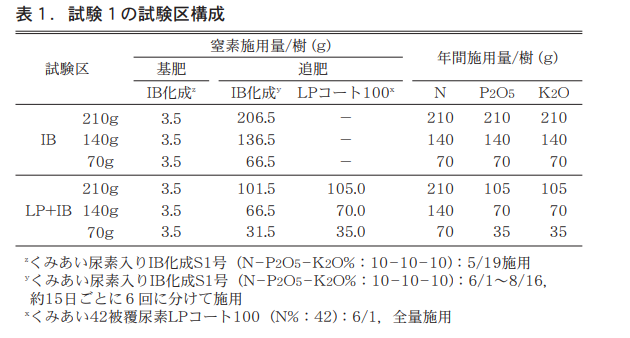
(4) Results and discussion
Summer fruit yield and fruit weight were better at 210 g/tree and 140 g/tree of nitrogen application than at 70 g/tree (Table 2). From late July onward, leaf color remained lower on the 70 g/tree than on the 140 g/tree and 210 g/tree (Fig. 1). Since management up to 4 weeks after flowering is important for fruit development of passion fruit (Ishibata, 1993), it was considered that the amount of nitrogen required for tree growth and fruit development was applied when nitrogen application was 140 g/tree or more, thus maintaining good nutritional status of the trees. No differences in summer fruit yield or fruit weight were observed among the fertilizer treatments.
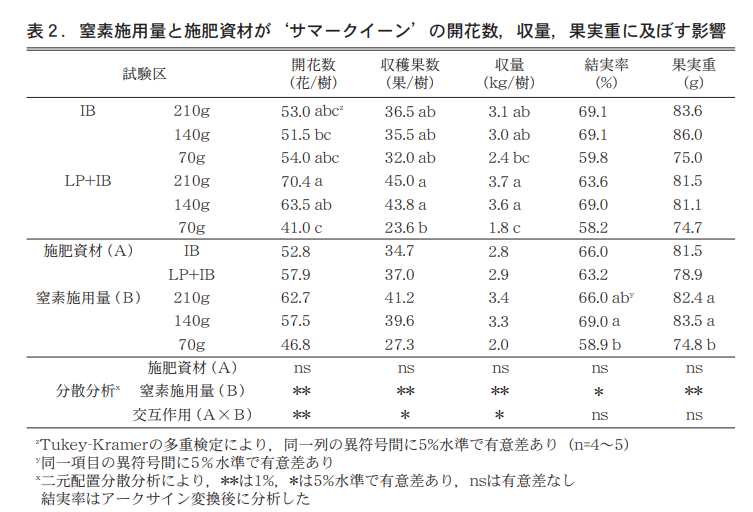
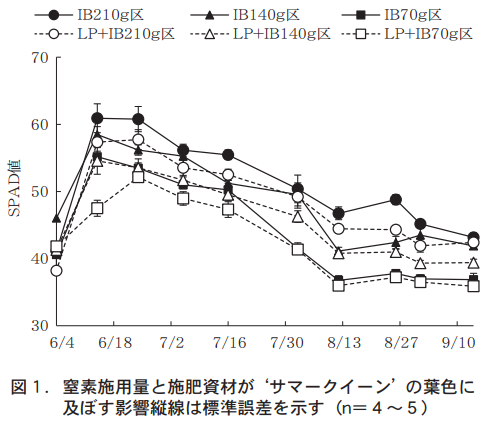
Flowering began in the third half of June, increased rapidly from the first half of July, and almost ended in the fourth half of July, but flowering was observed again in the LP+IB 140 g and LP+IB 210 g areas in the second half of August (data omitted). This suggests that flowering may occur even during the high-temperature period if the tree conditions are favorable.
収穫日数は窒素施用量による差が認められ,210g/樹が70g/樹よりも長かったが,糖度や酸度に窒素施用量と施肥資材による差は認められなかった(表3) 。
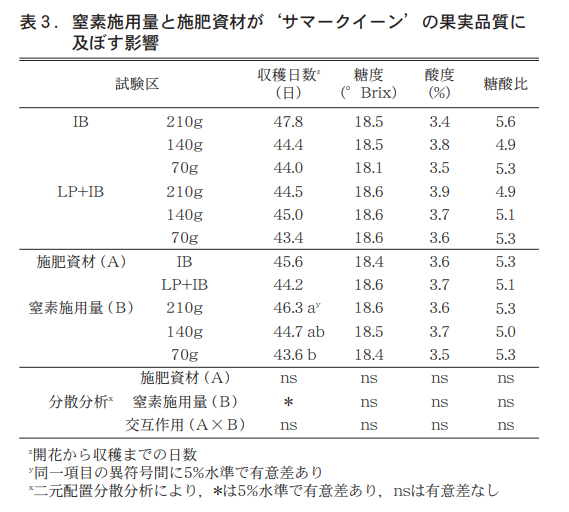
These results indicate that a nitrogen application rate of 140 g/tree or more is necessary to improve the yield of summer fruits. Considering labor and cost, the combination of LP Coat 100 and IB chemical was considered more suitable than IB chemical alone (Photo 1).
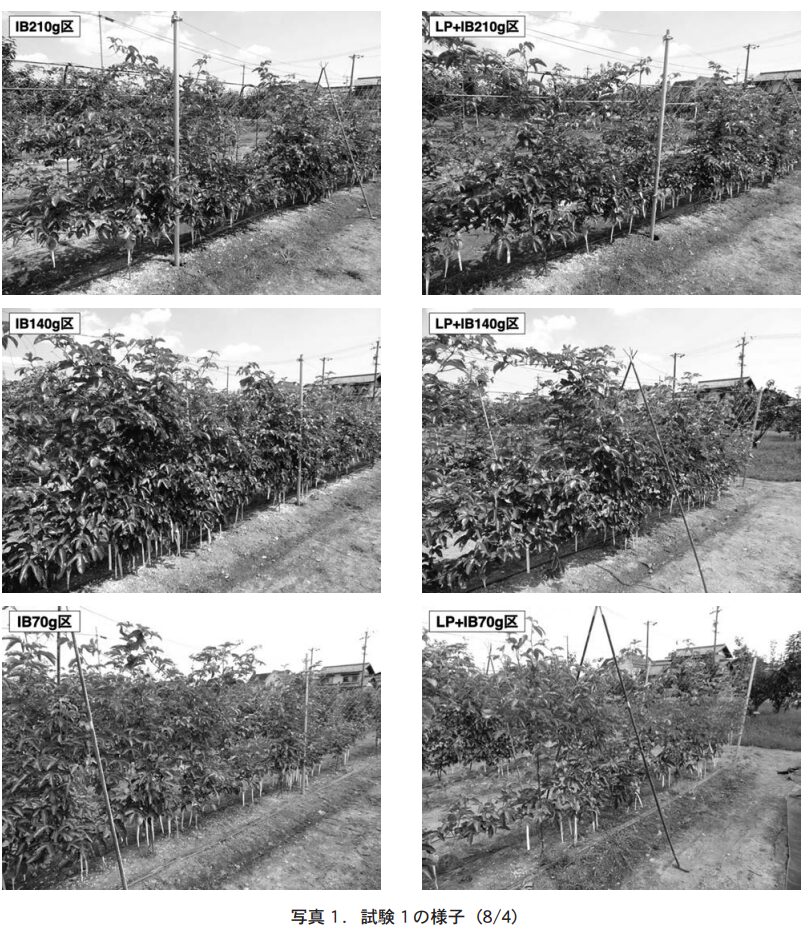
3. study of combination ratio of fertilizer materials [Test 2].
(1) Purpose
Based on the results of Trial 1, the combination ratio of LP Coat 100 and IB Chemicals was examined with a nitrogen application rate of 140 g/tree. The ratios were 50:50 as in test 1, 90:10 with one shot of base fertilizer, and 75:25 in between.
(2) Outline of cultivated species
Seedlings were cut and raised the year before planting as in test 1. Seedlings with a grass height of approximately 1.2 m were planted on May 1, 2017 at 2.0 m between plants and 2.5 m between rows, and thereafter cultivation was managed as in test 1.
(3) Testing method
The test plots were set up with different combinations of fertilizer materials (Table 4), with three to five replications per plot, one replication per tree. As in test 1, leaf color, number of summer fruit openings, yield, and fruit weight were investigated, as well as sugar content and acidity of fruit harvested from August 5 to 11.
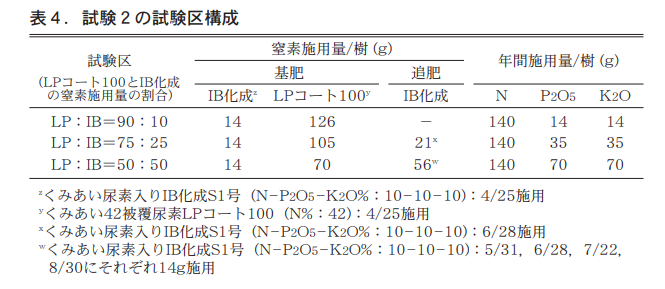
(4) Results and discussion
No differences in yield, fruit weight, fruit quality, or leaf color were observed among the combinations of fertilizer materials (Tables 5 and 6, data omitted). Considering this and the workability and fertilizer cost, it is clear that a one-shot application of base fertilizer with a 90:10 ratio of LP Coat 100 to IB Chemicals is an effective and practical method of fertilizer application.

Summary
The results of this test showed that the summer seed yield could be significantly improved by cultivating with a one-shot application of basal fertilizer (126 g/plant of LP Coat 100 and 14 g/plant of IB Chemicals as basal fertilizer). The yield of summer fruits (160 trees/10a) was about 0.6 t/10a when cultivated with this fertilizer method in a one-character tailoring system.
In addition, the development of cultivation technology for summer fruits by pot cultivation has recently been studied (Suzuki et al., 2019). Although pot cultivation is costly in terms of materials, it is expected to be a new cultivation technique because it can yield about 1.6 times more than ground cultivation and has excellent fruit quality with a high sugar-acid ratio.
The development of the technology introduced here was conducted by the National Institute of Agrobiological Sciences, National Institute of Agrobiological Sciences (NIAS) through the "Project for Development and Emergency Deployment of Innovative Technology (Regional Strategy Project): Analysis of the Potential for Domestic Production of Avocado, Passion Fruit and Other Subtropical Fruit Trees and Development of Cultivation Technology".
References
●石畑清武.1993.
パッションフルーツ (Passiflora edulis Sims)の花器及び果実の発育に関する研究.
鹿大農場研報.18:1−77.
●熊本 修・東 明弘・鈴木哲也・須崎徳高・橋本真帆・近藤友大・樋口浩和.2017.
パッションフルーツ栽培の現状と新しい栽培技術.
熱帯農業研究.10 (1):7−17.
●農林水産省.2020.特産果樹生産動態等調査.
http://www.maff.go.jp/j/tokei/kouhyou/tokusan_kazyu/index.html
●鈴木哲也・新川 猛.2017.
施肥量が露地栽培パッションフルーツの収量および果実品質に及ぼす影響.
熱帯農業研究.10 (別2):79−80.
●鈴木哲也・杉浦真由・新川 猛.2019.
ポット栽培におけるパッションフルーツの収量および果実品質.
熱帯農業研究.12 (別2):13−14.
●宇都宮直樹.1989.
ムラサキクダモノトケイソウの新梢生長,開花・結実,果実生長に及ぼす温度の影響.
園学雑.58 (別1):112−113.
Labor saving in promotion cultivation of eggplant by total basal fertilizer application
Fukuoka Prefectural Agriculture and Forestry Experiment Station
森田 茂樹
Introduction.
福岡県は全国でも有数の促成栽培ナスの生産地であり,県内の主要な品目となっている。しかし,近年は生産者の高齢化や後継者不足に伴い,栽培面積および生産戸数は減少傾向にあり,生産面積の維持や各生産者の経営規模拡大を図る上で栽培管理作業の省力化が不可欠となっている。そのため,本県では2012年に気温や日射量が低下する冬期においても果実品質が優れる単為結果性ナス品種「省太」を育成し(古賀ら 2013) ,促成栽培における総労働時間の約21%を占める着果促進処理作業(玖波井・松島 2004)の省力化を図った。
In contrast, eggplant is planted in August or September and harvested from October to June of the following year, so it is necessary to apply fertilizer about 10 times per crop, especially after November, when mulch is applied. In addition to the general use of total basal application of fertilizer using a fertilizer with controlled fertilizer efficacy for paddy rice, a total basal application system is also being considered for leafy vegetables such as lettuce and Chinese cabbage (Takahashi 1998) and summer/autumn cultivation of tomatoes (Kogun 2001). In eggplant, "Promoted eggplant and bell pepper Ichihatsu 40" (16-16-8), a total basal application fertilizer for eggplant and peppers, has been developed, but its applicability to total basal application of fertilizer has not been studied in this prefecture. However, the applicability of this fertilizer to the cultivation of eggplant and pepper has not been clarified in this prefecture.
Therefore, in order to save labor for fertilizer application in the promotion of eggplant, we investigated the effect of total basal fertilizer application using "Promoted Eggplant and Bell Pepper Ichihatsu 40" on yield and quality in the promotion of "Shota".
test procedure
The trials were conducted in 2016 and 2017 in a single greenhouse (6 m wide, 20 m deep, medium-coarse-grained gray lowland soil) at the Vegetable Department of the Fukuoka Prefectural Agriculture and Forestry Experiment Station. Two days before planting, 400 kg/10 a of "Promoted eggplant and green bell pepper Ippatsu 40" was applied in the rows in the total basal fertilizer zone (hereafter, total basal fertilizer zone), and 400 kg/10 a of compound fertilizer "Hakata eggplant basal fertilizer No. 1" and 60 kg/10 a of "Covered chemical L588" were applied in the conventional zone, respectively. In the conventional area, the fertilizer was applied at a rate of 45 kg/10a per application of compound fertilizer "Hakata Eggplant Fertilizer" at 20-30 day intervals starting on October 20 in both years, and was applied 9 times in 2016 and 10 times in 2017 on the ridges and shoulders of the ridges.
In both years, the seedlings were planted on September 8 before the first flower in a single row with 150 cm wide rows and 60 cm between plants, and four main branches were planted in a V-shaped row. The temperature in the facility was heated by a heater so that the minimum temperature in the facility did not fall below 10°C from December to mid-April. 4 and 3 plants per plot were tested in 2016 and 2017, respectively, with 3 replications of each test.
test result
Average temperatures in the facility and average soil temperatures were approximately 1-2°C lower from late September to mid-February in 2017 than in 2016, and remained similar in both years after late February (Figure 1). Although there were inter-annual differences in product fruit yield and product fruit percentage, there were no significant differences due to differences in fertilizer application methods. There were no significant differences in one-fruit weight among years or among test sections (Table 1).


Nitrogen leaching of LP-coated fertilizers in "Promoted Eggplant and Bell Pepper Ippatsu 40" was slightly higher from early September to late October in FY2017 than in FY2016 for LPS120, but lower from early November to late December, and remained generally similar thereafter (Fig. 2). FY 2017 was less from late November to early March and from early to mid-April compared to FY 2016, but values were comparable during the rest of the year (Figure 2).

The nitrate nitrogen content in the soil within the rows in the total basal fertilizer area was lower than that in the conventional area until mid-January in both years, but increased after late March (Figure 3). The cost per 10a of the 2017 trial was ¥90,000 for the in-row application and ¥103,500 for the full-layer application of "Promoted eggplant and green pepper Ippatsu 40," compared to ¥142,600 for the conventional method (Table 2).


consideration
LP Coat contained in "Promoted Eggplant and Bell Pepper Ippatsu 40" is a temperature-dependent fertilizer, and the amount of nitrogen leached is controlled by the temperature of the applied soil (Fujita 1996). Nitrogen leaching of LP Coat fertilizers in this study was lower in FY 2017 than in FY 2016 from early November to late December for LPS120 and until early March for LPS200. This is thought to be because the average soil temperature in the facility in FY2017 was approximately 1-2°C lower than in FY2016 from late September to mid-February, which delayed the onset of nitrogen leaching of LP-coated fertilizer and resulted in lower leaching.
The nitrate nitrogen content in the soil within the rows in mid-January was lower in the full-supply fertilizer treatments in FY2017 than in FY2016, but this may also be due to the difference in soil temperature, which slowed the leaching of LP coat and the degradation of CDU, a slow-release nitrogen fertilizer contained in this fertilizer. On the other hand, when the nitrate nitrogen content was compared among the test plots, the total fertilizer plots were lower than the conventional plots until mid-January in both years, but the nitrate nitrogen content was the same or higher in the total fertilizer plots from late March onward. The leaching of LPS200 from LP-coated fertilizers increased rapidly from mid-March in both years as soil temperature increased, which is thought to have maintained high nitrate-nitrogen content in the total-supplemented area from mid-March onward.
Eggplant belongs to a group of vegetables with high optimal growth temperatures, and growth and fruit development are known to be highly correlated with temperature. In this study, the commodity fruit yield was lower in FY2017 compared to FY2016, which may be due to the higher average temperature in the facility in FY2016 compared to FY2017, which accelerated growth and increased the number of harvested fruits.
Fujii and Itaki (1954) reported that low fertilizer application reduced the number of eggplant blossoms and, accordingly, the number of harvested fruits. In both years, the total fertilizer application yielded the same amount of product fruit as in the conventional treatment, and the product fruit percentage and one-fruit weight were also the same as in the conventional treatment. These results suggest that this fertilizer is suitable as a total basal application fertilizer for the promotion cultivation of monocotyledonous eggplant "Shota".
According to a survey conducted in Fukuoka Prefecture, the labor time required for one application of fertilizer in eggplant promotion cultivation is as short as 0.4 hours per 10 a. However, the labor load for fertilizer application while lifting mulch is heavy. In total basal fertilizer application, about 10 times of fertilizer application per crop is unnecessary, thus reducing labor time by 4 hours per 10a and labor load for fertilizer application throughout the cultivation period. In addition, the timing of fertilizer application depends largely on many years of cultivation experience, and for inexperienced successors or new farmers, a delay in fertilizer application may lead to poor growth and reduced yield. However, with total basal fertilizer application, there is no delay in fertilizer application, and this is expected to contribute to the stable production of eggplant.
The cost per 10 a of fertilizer application was approximately 90,000 yen for full-base fertilizer cultivation with in-row application of this fertilizer, which was approximately 53,000 yen less expensive than conventional fertilizer cultivation. The cost per 10a was also about 39,000 yen less than the conventional method when the fertilizer was applied in a full layer, which is more similar to the field application method, and the total basal application of this fertilizer is considered to be cost-effective.
summary
In the promotion cultivation of the monocultivated eggplant "Shota" in Fukuoka Prefecture, it was found that total basal fertilizer application using "Promoted Eggplant and Bell Pepper Ichihatsu 40" was comparable to conventional fertilizer application in terms of both yield and quality, and that labor saving by eliminating fertilizer application and reduction in fertilizer costs were possible. In addition, we also conducted a one-year test in 2017 with PC Chikuyo, a monocotyledonous eggplant whose production rate has been increasing among eggplants grown under accelerated cultivation in the prefecture, and confirmed that the yield and quality were equivalent to those obtained in the conventional cultivation. Currently, at production sites, fertilizer application methods are being considered that are more suited to the promotion-cultivated eggplants in this prefecture, such as the simultaneous application of other fertilizers in addition to "Promoted Eggplant and Bell Pepper Ichihatsu 40" to stabilize early growth.
works cited
●藤井健雄・板木利隆(1954)
茄の着果周期に関する研究.園学雑23:1−8.
●藤田利雄(1996)
ポリオレフィンによる肥料被覆技術の発明と被覆尿素の工業化.
土肥誌67:247−248.
●古賀 武・下村克己・末吉孝行・三井寿一・浜地勇次・齊藤猛雄・松永 啓・斎藤 新(2013)
単為結果性ナス新品種「省太」の育成.
福岡農総試研報32:52−58.
●小管佐代子・桑野伸晃・三枝正彦(2001)
トマト栽培における肥効調節型窒素肥料を利用した全量基肥施肥法.
土肥誌72:621−626.
●玖波井邦昭・松島貴則(2004)
花粉媒介昆虫と天敵を利用した施設ナス栽培体系の経営的評価.
Kochi Agricultural Technology Center Bulletin 13: 1-12.
●斎藤 隆(2004a)
Ⅱ苗の発育の生理,生態.農業技術大系 野菜編 5ナス基礎編.
農文協,東京,p37−52.
●斎藤 隆(2004b)
Ⅵ果実発育の生理,生態.農業技術大系 野菜編 5ナス基礎編.
農文協,東京,p101−118.
●高橋正輝(1998)
肥効調節型肥料による施肥技術の新展開5.野菜の施肥技術(その2) .
土肥誌69:303−309.